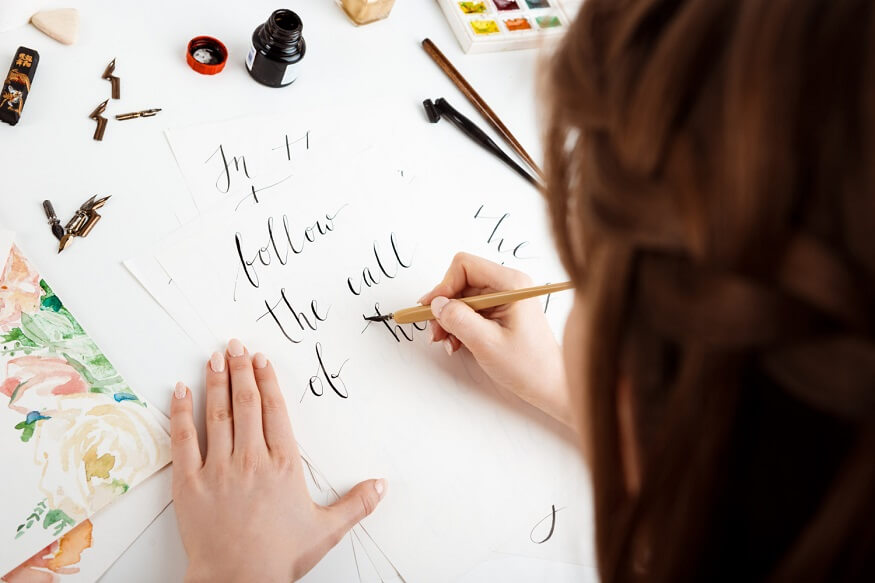Calligraphy is often referred to as the art of beautiful writing. With a rich history spanning centuries and cultures, Calligraphy not only produces beautiful artwork but also brings numerous benefits, such as improved handwriting, honed fine motor skills, and boosted creativity.
Undoubtedly, it is an engaging activity for kids. This blog will introduce five types of calligraphy styles for children you must know.
- Foundational Hand
- Uncial
- Chancery Italic
- Gothic
- Brush Lettering
The Foundational hand calligraphy draws inspiration from early mediaeval scripts, combining legibility with artistic flair. It is aptly named ‘foundational’ as it lays the foundation for learning other forms of calligraphy. Its structured and well-proportioned letterforms make it an ideal choice for educational purposes, formal documents, and artistic projects alike.
The Foundational Hand calligraphy is one of the easiest styles to learn, making it a perfect starting point for beginners, especially kids. Foundational Hand, also known as Bookhand, came to prominence in the eleventh century.
The letters in foundational hand calligraphy are clear, round, and well-spaced. Each letter is drawn with a high level of precision, maintaining consistent angles, and following a proportional template.
It exhibits a uniform line quality and size, with clear and easy-to-read letters – features that make it a favourite among novice calligraphers. It consists of a few basic strokes which children can master with just a little practice.
Primary tools used in foundational hand calligraphy include the calligraphy pen, surfaced paper, and ink. A broad-edged nib is generally preferred for foundational hand calligraphy. The paper used should resist bleeding or feathering, while the ink should flow smoothly from the pen nib and absorb properly into the paper. Form and precision are important in foundational hand calligraphy.
Also Read: Loose Parts Play for Kids – What You Need to Know
Another type of script that children can master handily is Uncial. Originating from the fourth to eighth centuries by Latin and Greek scribes, Uncial is characterised by rounded forms and few connecting letters. It is a writing style marked by majuscule letters and is devoid of any sharp angles.
The name ‘Unical’ is derived from ‘unicus’, a Latin term implying ‘unique’ or ‘sole’. This bears testament to the uniqueness of the script as compared to the more angular form of scripts like the Roman cursive and the rustic capitals. As a calligraphy style, Unical embraces a certain uniformity, flaunting rounded shapes, no ligatures, and demonstrating a slight tilt to the left with consistent letter spacing.
This calligraphy style is incredibly easy; hence it is quite suitable for children who are just starting to venture into the world of calligraphy.
Also Read: Rebus Puzzles: What Are Rebus Puzzles? Types, Tips to solve, benefits
Chancery Italic, born in Renaissance Italy, is also one of the most child-friendly calligraphy styles. It is known for its elegance and practicality.
Its calligraphy letters have a distinct slant, giving this script a sense of movement and dynamism. Individual letters in Chancery Italic calligraphy are detailed, with each letter featuring an entry stroke, a body, and an exit stroke. It also utilizes the basic downward stroke, a lighter upstroke, the oval, and the branching stroke.
The script features distinguishing characteristics such as varying line thickness, and distinctive looping ascenders and descenders. Mastery of chancery italic calligraphy requires attention to detail, patience, and a good understanding of nuances such as pen angle, line spacing, and letter proportion.
The strokes are formed by controlling the angle and pressure on the pen, which creates a nice balance between simplicity and complexity, a feature that makes Chancery Italic engaging for kids.
Also Read: What Are Pangrams? Benefits For Kids
Dating back to the Middle Ages, the Gothic style of the script may appear complex compared to the other styles on this list, but it is relatively simple to create.
Gothic calligraphy originated from Gothic minuscule, which evolved into angular, pointed, and narrow shapes. This was predominantly due to the instruments used – the quill pen, which could produce sharp and swift strokes.
One notable characteristic of Gothic calligraphy is the emphasis on vertical lines. The letterforms are tall and narrow, accentuated by strokes that run perpendicular to the writing line. Gothic scripts have a tightly packed appearance due to the minimal space between the letters.
Children will engage with this script as it can foster their sense of patience and precision by carefully constructing each letter. However, this style should be approached once the child is comfortable with basic strokes and letter forms.
Also Read: Teach Kids to Make Candles
Brush lettering is a modern calligraphy style that is growing in popularity among kids and adults alike. It involves the use of brush pens or paint brushes instead of traditional calligraphy pens.
The pen encompasses a flexible brush-like tip which reacts to changes in pressure, resulting in thick and thin strokes. The substantial flexibility found in the brush pen is critical in the overall appearance of the scripts designed through their use
Brush lettering is defined by differing line thickness within a letter made by varying pressure on the brush. It is appealing to children due to its less rigid form and the variety of bold, vibrant colours that can be achieved with brush pens.
Brush lettering calligraphy is not reserved for experts; it’s a skill that can be honed through practice. It aids in developing hand-eye coordination, patience, and focus through the precise movements and the rhythm it calls for. The process is often considered therapeutic, contributing to mental well-being by reducing stress levels.
As brush lettering calligraphy gains recognition, workshops, tutorials, and online platforms are providing more avenues for amateurs to learn and practise this form of art. Its beauty, versatility, and convenience make it a preferred choice for creating personalised greeting cards, wall hangings, wedding invitations, signboards, and even in graphic design.
Also Read: 16 Spatial Reasoning Activities for Kids
Conclusion
Every calligraphy writing style has its unique appeal and children can learn various benefits from these listed styles – be it fine motor skills, patience, precision, or simply the appreciation of art and creativity. The goal of teaching calligraphy to kids should be to cultivate their love for the art form, hence it is of utmost importance to keep the process fun and engaging.










